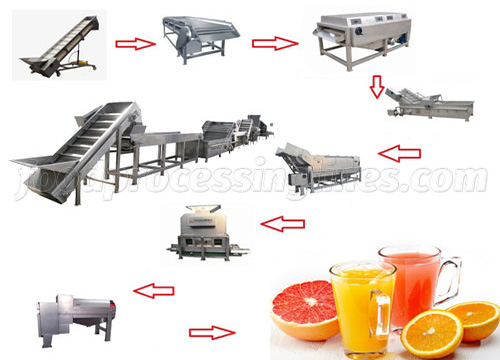Creating fruit juice is a delightful process that transforms fresh fruits into a refreshing and nutritious beverage. Whether making juice for personal enjoyment or on a commercial scale, the process involves several critical steps to ensure the final product is of high quality, safe to consume, and delicious. From selecting the right fruits to bottling the juice, every stage in juice production requires meticulous attention. Below, we delve into the intricacies of how to make fruit juice, ensuring that each glass is bursting with flavor and vitality.

all machines of orange juice processing line
Selecting the Perfect Fruits
Choosing High-Quality Produce
The journey to a perfect glass of fruit juice begins with the selection of fresh fruits. It’s essential to choose fruits that are ripe and free from blemishes, mold, or signs of spoilage. The ripeness of the fruit significantly impacts the sweetness and overall flavor profile of the juice.
Washing and Preparing the Fruits
Once the right fruits have been chosen, they must be thoroughly washed to remove dirt, pesticides, and bacteria. Fruits should be rinsed under running water and scrubbed gently if necessary. For fruits with thick peels, such as citrus, a vegetable brush can be used. After washing, prepare the fruits by removing any peels, seeds, or pits as needed.
Extraction: Unlocking the Juice
Manual vs. Mechanical Juicing
Juice can be extracted either manually or mechanically, depending on the tools available and the quantity of juice desired. Handheld reamers or citrus presses are adequate for small batches, while electric juicers or commercial pressing equipment can accommodate larger volumes.
Cold Pressing for Nutrient Retention
Cold pressing is a method that uses a hydraulic press to extract juice without adding heat, thereby preserving the maximum amount of nutrients and enzymes. This method is preferred for its ability to maintain the fruit’s natural flavor and health benefits.
Centrifugal Juicing for Efficiency
Centrifugal juicers work by shredding the fruit and spinning it at high speed to separate the juice from the pulp. This method is faster and more suitable for harder fruits, but it may introduce heat and oxidation, which can affect the quality of the juice.
Filtration: Refining the Texture
Pulp Preferences
After juicing, you may choose to strain the juice through a fine mesh or cheesecloth if a smoother, pulp-free juice is desired. The amount of pulp to retain in the juice is a matter of personal preference, with some people enjoying the texture and added fiber it provides.
Clarity and Consistency
For commercial juice production, additional filtration processes may be used to achieve clarity and consistency across batches. This might include using centrifugal separators or other advanced equipment that further refines the juice.
Preservation: Ensuring Freshness
Pasteurization for Safety
To extend the shelf life and ensure the safety of juice, pasteurization may be employed. This process involves heating the juice to a specific temperature for a set time to eliminate harmful bacteria and pathogens. Pasteurization is essential for commercial juice products but can be skipped for fresh, immediately consumed homemade juices.
Innovative Non-Thermal Techniques
For those looking to maintain the raw qualities of the juice, non-thermal preservation methods such as High Pressure Processing (HPP) can be used. HPP inactivates microbes without the use of heat, thus preserving the fresh taste and nutrients.
Packaging: Sealing in Freshness
Choosing the Right Containers
The final step is to transfer the juice into clean, food-grade containers. Glass bottles are excellent for preserving flavor and preventing contamination, while BPA-free plastic bottles offer a lightweight and shatter-resistant alternative.
Airtight Sealing
It is crucial to seal the containers tightly to prevent oxidation, which can degrade the quality and taste of the juice. For homemade juices, a simple twist-on cap is sufficient, whereas commercial juices may use specialized sealing methods to ensure airtight packaging.
Storage: Maintaining Quality
Refrigeration
Freshly made juice should be refrigerated immediately to slow down the growth of bacteria and preserve its freshness. Keep the temperature consistently cold to ensure the juice remains safe to drink and retains its nutritional value.
Shelf Life Considerations
Even when properly stored, fresh juice has a limited shelf life. Homemade juice should be consumed within a few days, whereas commercially produced juice may last longer due to the preservatives and processing methods used.
Conclusion: The Essence of Pure Fruit Juice
Making fruit juice is a process that combines art and science, requiring passion and precision at every step. From selecting ripe, flavorful fruits to efficiently extracting the juice, and ultimately preserving the vibrant essence of the fruit, each phase contributes to the overall quality of the beverage. Adhering to proper hygiene practices and storage conditions ensures that every sip of juice is not only delicious but also safe and wholesome. Whether enjoyed fresh or as part of a commercial range, fruit juice remains a timeless, invigorating drink that captures the pure taste of nature’s bounty. And if you want to setup a fruit juice factory, we can also provide you the best solution.
